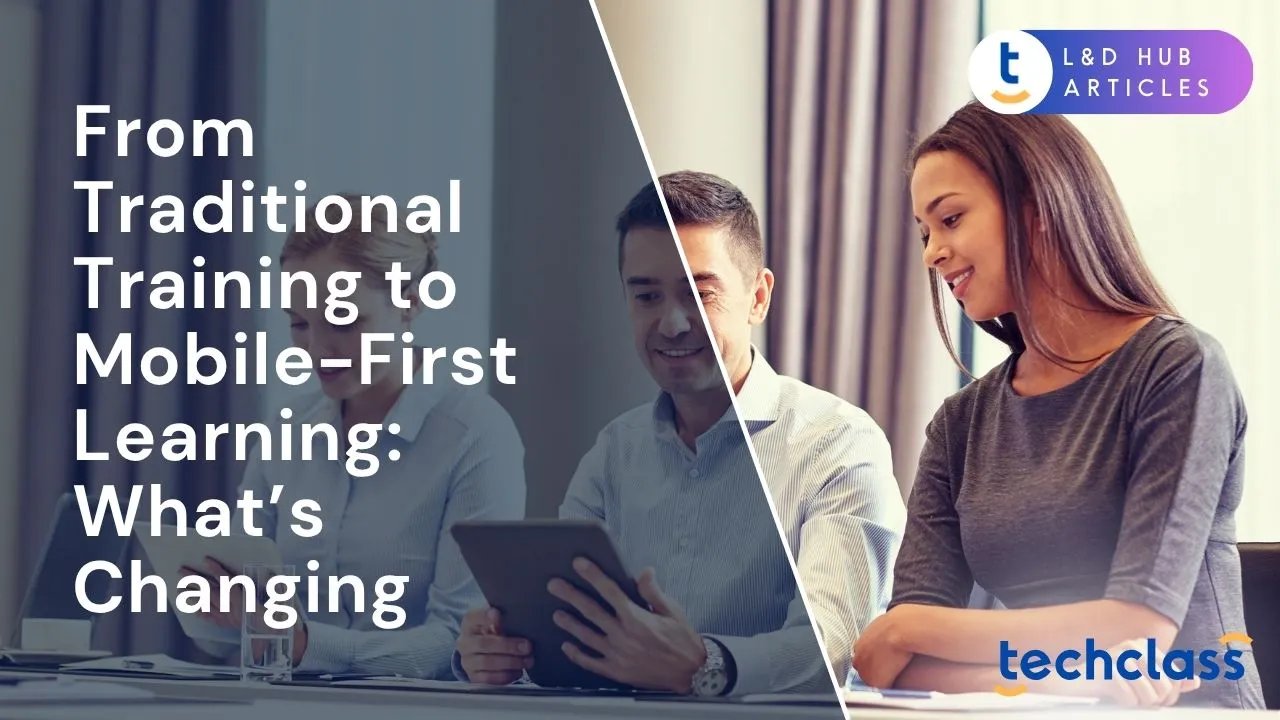
Not long ago, corporate training often meant day-long workshops, thick binders of training manuals, and PowerPoint lectures in a conference room. These traditional training methods, while familiar, are increasingly out of sync with today’s fast-paced, digital work environment. Modern employees are more dispersed (with remote and hybrid work on the rise) and more tech-savvy, often juggling tight schedules that make it challenging to attend scheduled classroom sessions. In this landscape, mobile-first learning has emerged as a game-changer. This approach puts learning literally in the palm of employees’ hands, everaging smartphones and tablets to deliver knowledge anytime, anywhere. For HR professionals and business leaders, the shift from traditional training to mobile-first learning represents a fundamental change in how we develop our workforce. It promises greater flexibility, engagement, and efficiency. But what exactly is changing, and why does it matter across industries and business sizes? Let’s explore the key differences and benefits as organizations transition from old-school training models to a mobile-first learning strategy.
Traditional instructor-led training and lengthy eLearning courses have been the norm in corporate learning for decades. These methods typically require employees to step away from their daily duties to attend in-person seminars or complete hours-long modules on a desktop computer. While this approach can be effective for certain topics, it shows clear limitations in the modern workplace. For one, scheduling a session where everyone is available at the same time is often difficult – especially for companies with 24/7 operations or a globally distributed workforce. Employees also often find it hard to retain huge volumes of information delivered in one sitting. Research on the “forgetting curve” shows that much of what is learned in a long session can be forgotten within days if not reinforced. This means a lot of time (and money) spent on traditional training may not translate into lasting skills or behavior change.
Moreover, traditional training can be logistically cumbersome and costly. Organizations must arrange for trainers, physical space, travel (if staff are spread across locations), and time off the job for participants. These events might occur only annually or quarterly, making it hard to address knowledge gaps or updates in real-time. In fast-moving industries, by the time a scheduled workshop happens, some content might already be outdated. Perhaps most critically, one-size-fits-all training doesn’t account for different learning paces and styles. In a typical classroom, some learners might be bored while others feel overwhelmed. All these challenges have prompted businesses to seek more agile and learner-centric solutions, setting the stage for mobile-first learning.
Mobile-first learning refers to designing and delivering training with mobile devices as the primary medium. Instead of expecting employees to be tied to a desktop or a classroom, mobile-first learning meets them on their own terms: on their smartphones or tablets, whenever and wherever they are ready to learn. It’s not simply eLearning content shrunk down to a phone screen; it’s an approach that rethinks content format, length, and interactivity to suit on-the-go consumption. For example, a mobile-first course might consist of 5-minute modules optimized for small screens, with interactive quizzes that work with tap and swipe gestures.
This style of learning has gained traction because it aligns with how people already use technology. There are billions of smartphone users worldwide, and employees spend hours each day on their phones for both work and personal tasks. Chances are, many of your staff already use mobile apps to check email, manage projects, or communicate. Integrating training into that same mobile ecosystem makes learning far more accessible. Learners can progress through a course during a commute, on a lunch break, or from home – without needing a laptop or an in-person class. Importantly, “mobile-first” means training content is created with the mobile user experience in mind from the start (rather than being an afterthought). This ensures readability on small screens, quick load times, and mobile-friendly features like offline access or push notification reminders. In essence, mobile-first learning brings the flexibility of consumer mobile apps (think how we consume news or podcasts on our phones) to the realm of employee development.
One of the most obvious changes with mobile-first learning is the unprecedented flexibility it offers. Anytime, anywhere learning means employees are no longer bound by a classroom schedule or computer station. Whether an employee is on a shop floor, out in the field, or working from home, training is just a few taps away on their phone. This flexibility is extremely valuable in today’s work environment. For instance, frontline workers in retail or healthcare can access brief training modules between tasks or during breaks, rather than leaving their post for a half-day training session. A sales representative traveling for business might complete a new product training on the flight using a tablet. In the past, that time would be lost or unproductive for learning. Now it becomes an opportunity to upskill.
For HR and L&D (Learning & Development) leaders, this on-demand access helps ensure training is continuous rather than a one-time event. Learning can be woven into the flow of work. Crucially, it also supports the growing remote and hybrid workforce. When portions of your team are not in the office, mobile learning ensures everyone gets the same access to knowledge without requiring a video meeting or travel to headquarters. Studies have found that a majority of employees find it more convenient to access training from a mobile device compared to traditional methods. They can engage with content when they are most receptive – for example, reviewing a quick how-to video right before performing a relevant task, which reinforces learning at the moment of need. In short, mobile-first learning has removed the barriers of time and location that once constrained workplace training.
Mobile-first learning typically embraces microlearning, delivering content in bite-sized chunks. This is a stark departure from the long, exhaustive training manuals or hour-long lectures of traditional training. What’s changing here is the recognition that employees learn and remember more when information is given in focused, digestible pieces. For example, instead of a single 3-hour course on customer service skills, a mobile learning program might offer a series of ten 10-minute modules, each covering a specific sub-topic (like handling returns or empathizing with customers). Learners can complete these mini-lessons one at a time and revisit them easily for refreshers.
This microlearning approach has proven benefits for knowledge retention. By avoiding information overload and allowing learners to absorb one concept at a time, mobile learning helps combat forgetting. In fact, organizations have observed significantly higher retention rates with microlearning. Some reports indicate that mobile microlearning can improve knowledge retention by around 50% (or more) compared to traditional classroom training. The content is more likely to “stick” because learners can immediately apply small lessons to their job and then build on that foundation progressively. Short quizzes or exercises after each bite-sized module reinforce memory through practice.
Another benefit of bite-sized content is higher course completion rates. In traditional e-learning, it’s common to see employees start a long course but never finish it, due to time constraints or waning attention. With mobile-first micro-courses, completion rates skyrocket. Employees are far more likely to finish a 5-minute lesson on their phone than a 60-minute course sitting at a desk. In fact, one industry statistic showed that while only about 20–30% of learners complete lengthy e-learning courses, completion for microlearning modules can exceed 80%. In summary, by breaking training into snackable pieces, mobile-first learning not only fits better into busy workdays but also leads to better knowledge retention and application on the job.
Another key change with mobile-first learning is the level of engagement and interactivity it brings to employee training. Traditional training often meant slide presentations or reading through static text – formats that can struggle to hold people’s attention. Mobile learning, on the other hand, takes advantage of multimedia and interactive design to make learning more engaging. Modern mobile training platforms allow incorporation of videos, interactive quizzes, simulations, and even gamified elements (like points, badges, or leaderboards) to keep learners interested. The compact format of mobile content often forces designers to focus on the most engaging way to get a point across – for example, using a 2-minute animation or a scenario-based question, rather than a long-winded paragraph of text.
Employees respond well to these richer learning experiences. It’s not just a nice-to-have; engagement directly impacts how well the training is absorbed and remembered. When learning is fun, hands-on, or feels like a game, participation naturally increases. There’s evidence that mobile learning can lead to significantly higher engagement rates than traditional methods. For instance, one study by a workplace learning group found that training delivered via mobile boosted employee engagement by as much as 70%+ compared to old classroom formats. Higher engagement means employees aren’t just logging into a course because they have to, they are actively interacting with the material, which improves understanding and retention.
Interactivity also allows immediate feedback. On a mobile platform, an employee can answer a quiz question and instantly see the correct answer with an explanation. This instant feedback loop helps learners adjust and reinforce the correct knowledge on the spot. In contrast, in a traditional setting, an employee might not find out they misunderstood something until a later assessment or even until an error occurs on the job. Additionally, mobile learning often supports social features like discussion boards or chat, turning training into a more collaborative and interactive experience (even if learners are not all in the same room). In summary, the shift to mobile-first means training is no longer a passive, lengthy lecture, it’s now an active, engaging process that captures attention through interactivity and media, ultimately leading to better learning outcomes.
Mobile-first learning also enables a more personalized and learner-centric approach to training, which marks a big change from the one-speed-fits-all style of traditional instruction. In a classroom, every attendee has to go through the material at the same pace, and the content is usually aimed at the “average” learner. Mobile learning platforms, however, often allow individuals to learn at their own pace and even adapt the content to their needs. Learners can pause, rewind, or skip ahead in modules depending on their familiarity with the topic. If a concept is challenging, they can take extra time or repeat a short module; if it’s something they already know, they can move on without being held back by a fixed schedule or peers.
Furthermore, many mobile learning solutions incorporate adaptive learning technology or at least a variety of content formats to suit different preferences. For example, an employee might have the option to read a quick article, watch a demonstration video, or take a practice quiz, choosing the format that helps them learn best. Some systems use quizzes to gauge a learner’s existing knowledge and then recommend specific modules to fill in gaps (this is a basic form of personalization). As a result, training becomes more relevant to each individual. There’s less time wasted on information that a given employee doesn’t need or already knows. Instead, they can focus on the skills and knowledge most pertinent to their role and level.
This personalization is especially appealing to the modern workforce, which includes a large proportion of Millennials and Gen Z employees. These younger professionals are accustomed to on-demand, tailored content in their digital lives (think of how streaming services recommend shows or how apps deliver personalized feeds). They expect a similar flexibility in workplace learning. In fact, surveys have found that an overwhelming majority of employees (including older generations) prefer to learn at their own pace as opposed to attending scheduled, one-size-fits-all sessions. Mobile-first learning caters to that preference by giving control to the learner. When employees can chart their own learning journey, selecting modules based on interest or career goals and proceeding when they feel ready – they tend to be more motivated and take greater ownership of their development. This is a win-win: employees get a more satisfying learning experience, and employers benefit from a workforce that is truly building the right skills efficiently.
Switching to mobile-first learning isn’t just about making training more convenient or engaging, it also has significant implications for efficiency and cost-effectiveness. Companies are finding that modernizing their training in this way can save both time and money while improving performance outcomes. For example, consider the time factor: because mobile learning modules are shorter and more focused, employees spend less total time in training to achieve the same (or better) learning results. Various case studies have shown that training delivered via mobile can require substantially less time than traditional training. In one experiment by a financial firm, employees who used a smartphone app to complete a course finished about 45% faster than those who took the same course on PCs in the usual format. This is partly because mobile courses cut out fluff and get straight to core points, and partly because learners can utilize small pockets of time that would otherwise be wasted. For busy enterprises, less time in training means more time employees can devote to their primary job duties, without sacrificing learning.
There’s also evidence of productivity gains tied to mobile learning. When employees can access quick learning resources on demand, they can solve problems or refresh their knowledge in real time, leading to better job performance. One industry report noted that employees who engage with training on mobile devices reported a 43% increase in productivity, a remarkable boost that comes from being able to immediately apply learning on the job and reduce downtime.
From a cost perspective, mobile-first learning often reduces the direct expenses associated with training. Traditional training costs can include venue bookings, instructor fees, travel reimbursements, printed materials, and so on. Mobile learning significantly cuts these costs. Digital content, once produced, can be delivered to many employees at virtually no additional cost per person. There’s no need to fly an instructor to multiple locations or print hundreds of manuals when everything is accessible in an app. Additionally, improved knowledge retention and engagement mean companies get more value out of the training they deliver, employees actually use what they learn, which can reduce costly errors and turnover. Some organizations have calculated very high returns on investment (ROI) for modern learning initiatives. While results vary, it’s not uncommon to hear of companies saving hundreds of thousands of dollars by moving compliance and onboarding programs to mobile platforms. Even beyond hard dollar savings, the flexibility of mobile learning can lead to softer benefits like higher employee satisfaction with training, which contributes to retention of talent. All told, the mobile-first shift isn’t just a trend for the sake of employee preference; it’s also a smarter business decision that can make training programs more efficient and cost-effective.
With all these advantages, one might wonder if mobile-first learning is a perfect solution without any drawbacks. In truth, while it brings many positive changes, there are challenges and considerations for organizations transitioning to this model. First, not every type of training is ideally suited to a bite-sized mobile format. Highly complex topics or hands-on skills (like operating specialized machinery, for example) may still require longer-form training or in-person practice sessions. Companies often find the best approach is a blended learning strategy, using mobile learning for what it does best (quick refreshers, theory, concepts, scenarios, assessments) and complementing it with other methods (like workshops or mentoring) for skills that need personal guidance or physical practice.
Another consideration is ensuring that all employees have access to the necessary devices and know how to use the training apps. In many industries, employees use their own smartphones for work tasks, and mobile learning can piggyback on that. But if you have workers who are less tech-comfortable or don’t own modern devices, you’ll need to provide training on using the app or offer alternatives. There’s also the matter of distraction: mobile devices carry the risk of interruptions (messages, notifications unrelated to training). Good mobile-first design mitigates this with engaging content and by encouraging learners to focus in short bursts, but it’s a factor to be mindful of.
Content quality is another critical factor. Designing effective mobile learning isn’t as simple as chopping a PowerPoint into pieces. Organizations should invest in redesigning content for mobile, possibly using instructional designers who understand microlearning principles. It’s important that each module has a clear objective and that multimedia elements actually enhance learning rather than just entertain. Also, consider the bandwidth and offline access needs – employees in the field might not always have a strong internet connection, so providing downloadable content within the app can be very helpful (and many mobile learning platforms offer this feature).
Finally, a successful mobile-first learning initiative requires cultural adaptation. Managers and employees alike need to treat these short learning activities as legitimate training. HR can support this by integrating mobile learning completion into development plans or performance discussions. Leadership support is key: when managers encourage their teams to take advantage of on-demand learning (and perhaps even lead by example), it helps build a culture where continuous learning is normal. In summary, transitioning to mobile-first learning comes with some implementation challenges, but with careful planning – from choosing the right platform to crafting quality content and supporting learners, these challenges can be overcome. The payoff is a training approach that is more aligned with how people work and learn today.
The evolution from traditional training to mobile-first learning reflects a broader transformation in how we approach employee development. What’s changing is not just the format of training, but the entire philosophy behind it. We are moving away from rigid, infrequent, one-size-fits-all training events toward a model of continuous, flexible learning that puts the learner at the center. For HR professionals and business leaders across all industries, this shift offers an opportunity to make training more effective and more aligned with business needs. Employees can learn in the flow of work, acquire new skills faster, and stay engaged with development opportunities that feel relevant and convenient.
Adapting to this mobile learning future will likely be a necessity rather than an option. As the workforce becomes younger and more digitally native, expectations for accessible, technology-enabled learning will only grow. Already, surveys show that employees (especially Millennials and Gen Z) value employers who provide learning and growth opportunities that fit their lifestyle, and mobile-first learning is a clear way to deliver on that expectation. Moreover, business agility in a competitive environment depends on being able to upskill and reskill staff quickly. Mobile learning is proving to be a powerful tool in achieving that agility, whether it’s rolling out a new product training to a global salesforce in days, or sending a safety refresher to factory teams instantly across various locations.
In closing, the transition to mobile-first learning represents a significant positive change in corporate training. Companies that have embraced it are seeing higher engagement, better knowledge retention, and often improved performance metrics as a result. Those still relying solely on traditional methods may find themselves lagging in developing their talent. By understanding the changes discussed, from flexibility and microlearning to personalization and efficiency – organizations can craft a learning strategy that not only keeps pace with the times but also empowers their employees. The tools and technology are here today. The key is to align them with sound learning practices and a supportive culture. With that in place, the journey from the old training model to a mobile-first learning environment can unlock the full potential of your workforce in this digital age.
Mobile-first learning designs training content primarily for smartphones and tablets, offering flexibility, interactivity, and bite-sized modules, unlike traditional in-person or lengthy eLearning sessions.
Benefits include greater accessibility anytime and anywhere, improved engagement through interactive content, personalized learning paths, cost savings, and faster skill development.
Challenges include content design for mobile, ensuring device access, avoiding distractions, providing offline options, and fostering a culture that values mobile microlearning.
Microlearning delivers focused, short modules that reduce overload, improve retention by encouraging repeated review, and increase completion rates significantly.
Interactivity boosts engagement, helps learners absorb material better, provides immediate feedback, and makes training more enjoyable and effective.
Not all; complex hands-on skills may need blended or in-person training, but mobile is highly effective for theory, quick refreshers, assessments, and conceptual knowledge.


